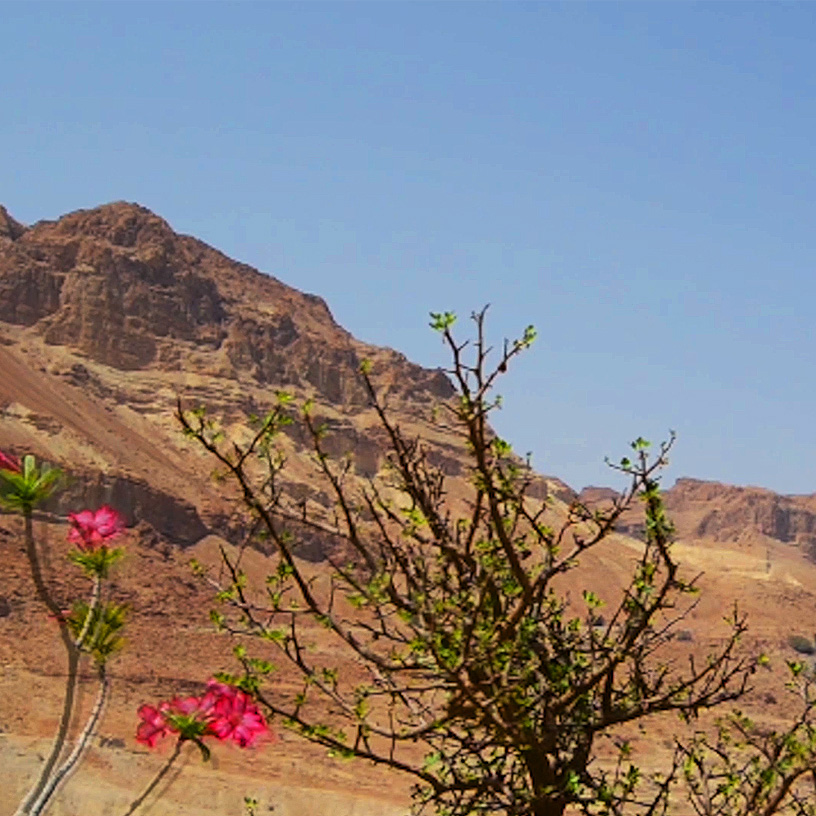AFARSIMON
in collaboration with Olga Kisseleva
Video installation

Now when the queen had thus demonstrated in words how deeply the king had affected her, her disposition was known by certain presents, for she gave him twenty talents of gold, and an immense quantity of spices and precious stones. (They say also that we possess the root of that balsam which our country still bears by this woman’s gift.)
Titus Flavius Josephus. Antiquities of the Jews.
Book 8, 6:6.
The afarsimon (also known as afarsemon or Balm of Gilead, Latin: Commiphora Gileadensis) is a religiously significant ancient plant that was cultivated in the Land of Israel from c. 950 BC till c. 70 AD. It belongs to the Burseraceae family, whose members are known for their flaking aromatic bark and the aromatic resin which they ooze. A relaive of the ancient afarsimon (Latin: Commiphora Opobalsamum, Commiphora Myrrha, Commiphora Habessinica) may still be found growing in the wild in Africa and Asia.
Afarsimon resin was part of the list of 11 ingredients that made up the Jewish incense offering (Hebrew: קטורת). The ancient Hebrew word afarsimon is derived from the Greek balsamon (βάλσαμον), which means "fragrance", and from the Aramaic, which means "tree".
The burning of the incense offering was a key religious ritual in ancient Judaism. The Bible instructed the Israelites to burn the offering at the Temple twice a day, and this commandment applied to both the First and the Second Temples in Jerusalem. The right to burn it was reserved to the priests (kohanim), who were the descendants of Aaron. Not even the King of Judah could perform this ritual. One of the first references to the afarsimon appears in the works of Josephus (Titus Flavius Josephus). In his book Antiquities of the Jews, he describes the time and cicrumctances under which the Queen of Sheba presented afarsimon saplings to King Solomon. The disappearance of the Jews from this area led to the disappearance of the plantations, and to the loss of the secret method of the production of this ancient incense. The world was deprived of the scent of afarsimon for two thousand years – i.e. from the moment of its extinction. But the memory of the afarsimon and its smell would live on for many centuries.
Nowadays, scientists have recreated the afarsimon in sufficient quantities to obtain an extract. Lilia Chak did the video “Afarsimon” in frame of her PhD research in Sorbonne (under the direction of Prof. Olga Kisseleva). The play of multi-layered reflections in the installation is intensified thanks to the inclusion of the documentary video portraits of the trees, which contribute to the emergent “polyphonic” effect. Lilia Chak has provided “video documentation” of the afarsimon tree, whereas Olga Kisseleva has done the same for the myrrh tree.
Shows:
- – Listening to Trees across the Jordan River. Prof. Olga Kisseleva`s solo exhibition. Lilia Chak participated in the exhibition in her video installations and photographs in frame of her PhD research in Sorbonne. Negev Museum of Art, Beer-Sheva, Israel. Curator: Dr. Dalia Manor.
Events:
- – MANOFIM. International conference, organised by Jerusalem Contemporary Art Festival, Jerusalem, Israel, with Dr. Lilia Chak, MindLab - Jens Hauser, Dar Moussafir, Carmel Barnea Brezner Jonas, Jonatan Omer Mizrahi, Tzaphira Allison Stern, Ivor Stodolsky, Marina Naprushkina, Dmitry Vilensky. Art, Biology and Ecology.
Media:
- – Olga Kisseleva, Lilia Chak,
Adopters of Creative Technologies
, article , The Encyclopedia of New Media Art: Volume 2: Artists & Practice, Bloomsbury, London. - – Lilia Chak,
Contemporary Practices in Bio-art: When a Tree Becomes an Artwork
, book published by Cambridge Scholars Publishing (ISBN: 1-5275-1949-X; ISBN13: 978-1-5275-1949-7; Pages: 562; Color illustration: 174). - – Prof. Ilia Rodov,
Concluding Remarks: Contemplations in the Desert on Nature, Creation, and Art
, article. Art and Biology: The Meeting Point. International symposium. Negev Museum of Art, Beer-Sheva, Israel. - – Lilia Chak,
Between Art and Science
, brochure (hebrew) for "Listening To Trees Across The Jordan River" exhibition. Negev Museum of Art, Beer-Sheva, Israel.
